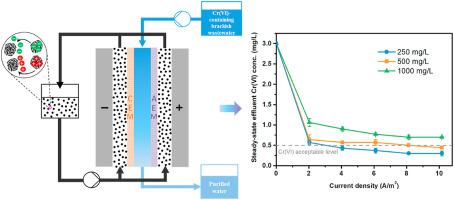Journal of Cleaner Production ( IF 9.7 ) Pub Date : 2021-10-18 , DOI: 10.1016/j.jclepro.2021.129417 Yi Dong 1, 2 , Wenle Xing 1, 2 , Kunyue Luo 1, 2 , Jing Zhang 3 , Jiaqi Yu 1, 2 , Wanwan Jin 1, 2 , Jiajia Wang 1, 2 , Wangwang Tang 1, 2

|
Effective treatment of Cr(VI)-containing wastewater is a great challenge faced by many industries with this situation further complicated by the coexistence of other ions such as Cl−. This study demonstrated the suitability and effectiveness of utilizing flow-electrode capacitive deionization (FCDI) for effective and continuous removal of Cr(VI) from brackish wastewaters. The effects of various influencing factors were systematically investigated, including applied current density, feed concentration of coexisting Cl−, hydraulic residence time (HRT), activated carbon loading, initial solution pH and other common coexisting anions. Results indicated that Cr(VI) was preferentially removed compared to Cl− with a high ion selectivity achievable, and Cr(VI) and Cl− had significantly different removal behaviors in many cases. The steady-state effluent Cl− concentration dropped almost linearly with the increase of current density, while the steady-state effluent Cr(VI) concentration dropped to a value under a small current density and decreased insignificantly in spite of the increase in current density. A larger HRT or activated carbon loading favorably contributed to a lower steady-state effluent concentrations of Cr(VI) and Cl−. Initial pH of feed water around 5–6 without pH adjustment was the most advantageous to the removal of Cr(VI). Different coexisting anions had inhibitory effects on the Cr(VI) removal to varying degrees and the carbonate species was found to have the greatest inhibitory effect. This study is of value in promoting FCDI as a viable technology for treatment of Cr(VI)-containing brackish wastewater.
中文翻译:

通过流动电极电容去离子 (FCDI) 从微咸废水中有效和连续去除 Cr(VI)
有效处理含 Cr(VI) 废水是许多行业面临的巨大挑战,由于其他离子如 Cl -的共存,这种情况进一步复杂化。该研究证明了利用流动电极电容去离子 (FCDI) 有效和连续去除微咸废水中的 Cr(VI) 的适用性和有效性。系统研究了各种影响因素的影响,包括施加的电流密度、共存 Cl - 的进料浓度、水力停留时间 (HRT)、活性炭负载、初始溶液 pH 值和其他常见的共存阴离子。结果表明,与 Cl -相比,Cr(VI) 被优先去除,可实现高离子选择性,Cr(VI) 和 Cl-在许多情况下具有显着不同的去除行为。稳态出水Cl -浓度随着电流密度的增加几乎呈线性下降,而稳态出水Cr(VI)浓度在小电流密度下下降到一个值,尽管电流密度增加,但下降不显着。较大的 HRT 或活性炭负载有利于降低 Cr(VI) 和 Cl - 的稳态流出物浓度-. 没有调节 pH 值的给水初始 pH 值在 5-6 左右最有利于去除 Cr(VI)。不同的共存阴离子对Cr(VI)的去除有不同程度的抑制作用,其中碳酸盐种类的抑制作用最大。这项研究对于促进 FCDI 作为一种可行的技术来处理含 Cr(VI) 的微咸废水具有价值。











































 京公网安备 11010802027423号
京公网安备 11010802027423号